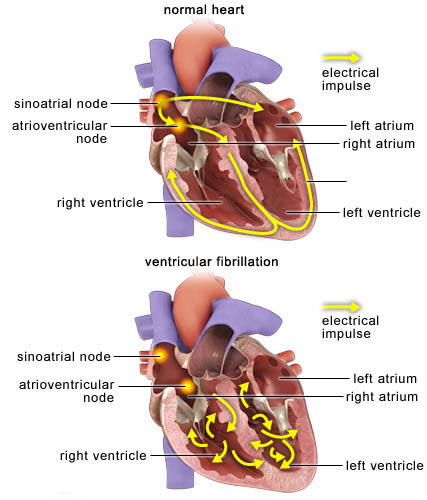Ventricular Fibrillation
Ventricular fibrillation (VF) is a severely abnormal heart rhythm (arrhythmia) that causes death unless immediately treated. VF is responsible for 75 - 85% of sudden deaths in persons with heart problems.
Causes
To pump blood out to the body, all areas of the heart normally squeeze (contract) at the same time. The heart’s upper chambers (the atria) contract before the heart’s bottom two chambers (ventricles). During VF, however, the contractions become disorganized.
The most common cause of VF is a heart attack, but VF can occur whenever the heart does not get enough oxygen or if a person has other heart disorders.
Conditions that can lead to VF include:
• Congenital heart disease
• Electrocution accidents or injury to the heart
• Heart attack
• Heart muscle disease, including cardiomyopathies
• Heart surgery
• Ischemia (lack of oxygen to the heart muscle because of narrowed coronary arteries or shock)
While most people suffering from VF have no previous history of heart disease, many have risk factors for cardiovascular disease, such as smoking, hypertension, and diabetes.

Symptoms of Ventricular Fibrillation
A person who has a VF episode will suddenly collapse or become unconscious, because the brain and muscles have stopped receiving blood from the heart.
The following symptoms may occur within 1 hour before the collapse:
• Chest pains
• Dizziness
• Nausea
• Rapid Pulse
• Shortness of breath
Exams and Tests
VF is an emergency condition. Seek immediate medical attention.
The pulse in the neck and groin area may be hard or impossible to feel. The person will be unresponsive. The health care provider will listen to the heart with device called a stethoscope. The heartbeats may not be heard, or they may be very irregular.
Treatment
Ventricular fibrillation is a medical emergency and must be immediately treated to save a person's life.
The emergency medical team will quickly examine the person while continuing CPR. The person will be taken to the hospital.
VF is treated by delivering a quick electric shock through the chest using a device called a external defibrillator. The electrical shock can immediately restore the heartbeat back to a normal rhythm.
Medicines may be given to control the heartbeat and heart function. Persons with heart muscle damage may need additional procedures, including a heart transplant. A cardiologist will look for potential causes of the VF.
An implantable cardioverter defibrillator (ICD) may be recommended for those who survive a VF attack and are at risk for future ones. The ICD has shown to effectively prevent sudden cardiac death.
Outlook (Prognosis)
VF can lead to death within a few minutes or a few days. The survival rate for a person who has a VF attack outside the hospital ranges between 2 - 25%.
Possible Complications
The most common complication of VF is sudden death, which is death that occurs within 1 hour after symptoms started.
For survivors of VF, complications include coma, reduced mental perception, and nerve problems similar to those seen after a stroke.
Prevention
An implantable defibrillator can help prevent future VF episodes in some patients. Others may need medicine to control the heartbeat.Many public places and airplanes now have automated external defibrillators for use in an emergency. Individuals may also buy such machines and keep them at home. The use of such defibrillators has proven to save lives.Another option for individual use is a defibrillator vest.It is a good idea for family members and friends of both VF survivors and patients with heart disease in general to take a CPR course. CPR courses are locally available through the American Red Cross, hospitals, or the American Heart Association.
Acknowledgements
Heart Rhythm Specialists of South Florida gives special thanks to the National Library of Medicine and National Heart Lung and Blood Institute whose Web sites aided in the research of the patient educational material provided above.






